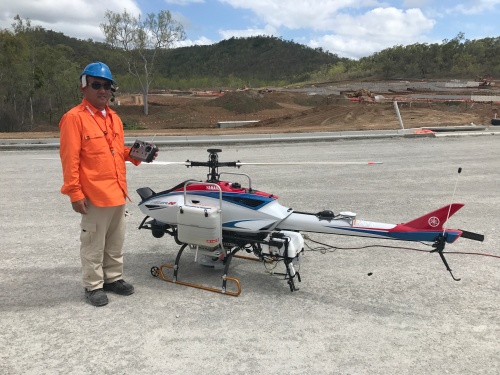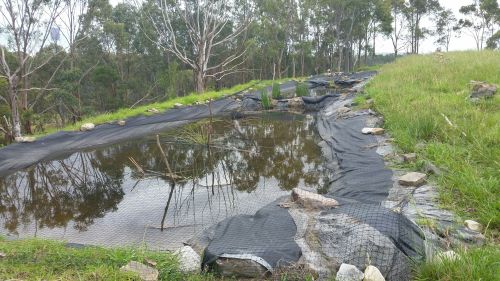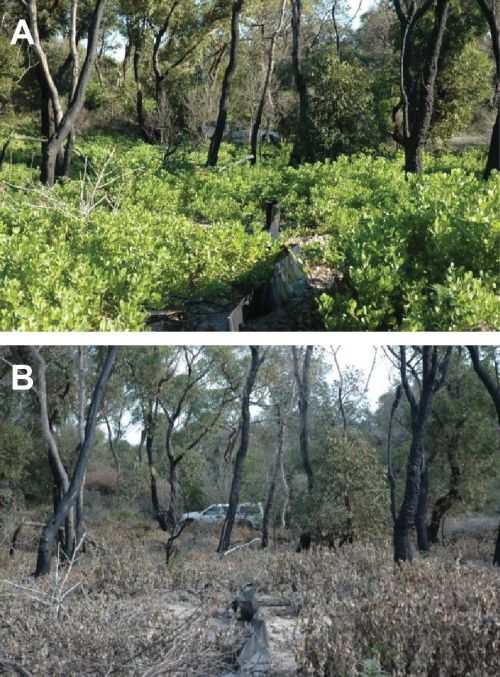Benjamin D Hoffmann
[Update of EMR feature – Hoffmann, Benjamin D and Simon O’Connor (2004) Eradication of two exotic ants from Kakadu National Park. Ecological Management & Restoration, 5:2, 98-105. https://onlinelibrary.wiley.com/doi/10.1111/j.1442-8903.2004.00182.x]
Key words. pest species management, invasive species, biosecurity

Figure 1. Kakadu staff in 2001 spreading formicide over a super-colony of African Big-headed Ant. This involved a team of people, aligned in a row, walking from one edge of the infested area to the other in parallel paths. (Photo courtesy of Simon O’Connor.)
Introduction. Invasive species management, especially eradications, has been at the forefront of biodiversity conservation gains over the past two decades. For example, over 1,200 invasive vertebrate eradications have been achieved on over 800 islands worldwide and the conservation benefits of such actions have been overwhelmingly positive and often dramatic. Efforts against invasive ants have also been particularly notable over the past two decades, with ants now being the second-most eradicated taxa globally having been eradicated from more than 150 locations, with the largest eradication covering 8300 ha. Two decades ago there were only 12 confirmed ant eradications using modern baits with a combined area totalling a mere 12 ha.
As reported in our original EMR feature, the last treatments against two invasive ants in Kakadu National Park, northern Australia: The African Big-headed Ant (Pheidole megacephala) and the Tropical Fire Ant, (Solenopsis geminata) were conducted in 2003; and the ants were declared eradicated two years later (Hoffmann & O’Connor 2004). At the time this was a globally significant eradication, and the positive outcome was a partial catalyst for the creation of many other relatively small exotic ant eradication attempts around Australia, including against Tropical Fire Ant on Melville island, and African Big-headed Ant on Lord Howe Island. Incidentally, the work coincided with the approximate timeframe of when two other highly invasive ant species were first detected in Australia: Red Imported Fire Ant (RIFA) (Solenopsis invicta), and Electric Ant (Wasmannia auropunctata), prompting the initiation of two massive national cost-shared eradication programs. One of these, the RIFA program, has become Australia’s second-most expensive eradication program at AUD $428 million as of at July 2019. Together, all of these actions put ants high on Australia’s biosecurity and environmental management radars, prompting the development of Australia’s Tramp Ant Threat Abatement Plan and yet even more eradication programs.

Figure 2. Ant bait being dispersed aerially by helicopter using an underslung spreader and side-mounted dispersers. (Photos Ben Hoffmann)
Further advancements in ant eradication programs. As Australia’s eradication programs became more numerous and larger, it became apparent very quickly that the methodologies and technologies available were insufficient to achieve success in the increasingly challenging conditions being encountered. In response, over the next two decades, there has been an impressive range of advancements that significantly improved our capacity to manage and eradicate invasive ant incursions.
The biggest issue was that work needed to be conducted over such large or inaccessible areas that ground-based work (Fig 1) was not feasible. So, treatments quickly became aerial, using multiple helicopter-based delivery platforms (e.g. underslung buckets and side-mounted hoppers, Fig 2). Even so, there have been locations that are too remote, too small, or too difficult (ie cliffs) to treat using a helicopter. To meet this challenge, in just the last five years treatments have been conducted for the first time using drones, and there is a great focus now to improve the technology so that it becomes more cost effective and more autonomous (Fig 3). This is occurring at such a pace that just a few years ago drones could only operate for a few hours at most on battery power, and only carry a few kilograms. This year we will be using a drone with unlimited flying capacity (petrol driven) that can lift 70 kg per load.

Figure 3. The Fazer with side-mounted bait carriers that can lift up to 40kg of payload. This is soon to be superseded by a drone that can lift a 70k g payload. (Photo Ben Hoffmann)
Assessments for the presence of ants, either before or after treatments, was originally very time consuming, involving teams of people walking ground very slowly and often utilising thousands of attractive lures (Fig 4). At most, only small ant populations (about less than 20 ha) within good working environments (ie open landscapes) could be assessed using teams of people, and it took large amounts of time. It was found very quickly that detector dogs could be trained on the scent of each ant species, and a single dog could cover more than five times the area of a team of people in a single day with greater efficacy (Fig 5). There are now more than 20 detector dogs operating in Australia and New Zealand that have been trained on the scent of four ant species. But even a team of dogs cannot fully cover entire areas at the landscape-scale, such as is the case for the RIFA program, especially in areas with long grass or rugged terrain. One of the saving technologies for the RIFA program has been the development of a multi-spectral sensor and associated algorithms that can identify RIFA nests from imagery captured by remote sensing (Fig 6). This allows program staff to assess just a few identified point locations in a landscape rather than the entirety of landscapes, to determine RIFA presence or absence. The next envisaged step is the development of biosensors that can detect the odours of target ant species, just like detector dogs, and with time these will become small enough to be transported by small drones throughout landscapes to detect ants.

Figure 4. An area covered with hundreds of flags marking spoonfulls of catfood being used as lures to attract African big-headed ant to assess eradication success or failure. (Photo Ben Hoffmann)

Figure 5. An ant detector dog searching for the presence of Red imported fire ant. (Photo courtesy of The State of Queensland (Department of Agriculture and Fisheries 2010–2019))
Australia was caught particularly unprepared two decades ago when the two new exotic ant species were detected for the first time because there were no baits registered for their management in Australia, so legally there were no treatment products that could be used. Even with the implementation of Emergency Use Permits for some unregistered products, as well as the use of the few products that were available for other species, it was often found that individual products could not be used in particular circumstances, especially around water, within crops and on organic farms. Additionally, available baits often did not have high efficacy. With time many baits (comprised of combinations of an attractive food laced with an active constituent) have been formulated and tested providing a greater array of baits that can be used on any new incursion and in numerous settings. The most recent has been the development of hydrogel baits that essentially deliver a liquid product in a solid form.

Figure 6 a and b. Multi-spectral camera flown underneath a helicopter to detect Red imported fire ant nests. (Photos courtesy of The State of Queensland (Department of Agriculture and Fisheries) 2010–2019)
Among the numerous advances described already, possibly the greatest development is on the threshold of becoming a reality, in the form of genomic solutions for individual species. RNA interference, and gene-drive technology are rapidly being developed for a suite of economically important species, and ants are among the taxa that are highest on the priority list as targets for this research. At best, these genomic advances promise to provide species-specific solutions, thereby alleviating the current non-target issues of using toxicants.
Conclusion. Our ability to eradicate ants has improved dramatically over the past two decades, with technologies and methodologies available now that were as yet not thought of back when our work was conducted in Kakadu National Park. New programs are constantly arising, and forging ahead in increasingly challenging situations, and a great deal of effort is placed in information-sharing among programs. Simultaneously there is a sustained focus to improve biosecurity at Australia’s borders, as well as throughout our region to help prevent the need for eradications in the first place.
Contact. Ben Hoffmann, Principal Research Scientist, CSIRO Health & Biosecurity (PMB 44 Winnellie NT 0822 Australia; Tel: +61 8 89448432; Email: Ben.Hoffmann@csiro.au).




























